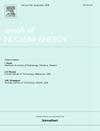研究压水堆中两种钍燃料的热学和力学行为
IF 1.9
3区 工程技术
Q1 NUCLEAR SCIENCE & TECHNOLOGY
引用次数: 0
摘要
钍作为一种核燃料,多年来一直是深入研究的主题。方案之一是在目前运行的压水堆核反应堆中采用钍。这项工作研究了两种钍燃料组合。第一种是钍与铀的组合,第二种是钍与钚的组合。本研究旨在研究稳态条件下燃料棒和包壳的热和机械行为。MCNP6 和 ANSYS-17.2(FLUENT 和静态结构)代码之间采用耦合,以获得温度和功率分布。为满足收敛标准,代码之间的数据交换采用了迭代过程,首先由热-液压 ANSYS-FLUENT 模型计算燃料、包层和冷却剂的实际温度分布;这些结果用于 MCNP 代码,以确定燃料棒的轴向功率分布。燃料和包壳的最大热应力值和位置也得到了证明。结果表明,钍铀燃料具有更好的性能,从而减少了包壳上的应力。本文章由计算机程序翻译,如有差异,请以英文原文为准。
Investigating thermal and mechanical behavior for two thorium fuel types in a PWR
Thorium, as a nuclear fuel, has been the subject of intensive research for many years. One of the options is the adoption of thorium in currently operated nuclear PWRs. In this work two combinations of thorium fuel are investigated. The first contains thorium with uranium, while the second contains thorium with plutonium. The present research aims at studying the thermal and mechanical behavior of the fuel rod and clad under the steady state conditions. Coupling is applied between MCNP6 and ANSYS-17.2 (FLUENT and Static Structure) codes to obtain temperature and power distribution. An iterative process is associated with the exchange of data between codes to meet the convergence criteria, starting by the thermal–hydraulic ANSYS-FLUENT model to calculate actual temperature distributions of fuel, clad and coolant; these results are used in the MCNP code to determine the axial power distribution in the fuel rod. The value and the location of the maximum thermal stress of the fuel and clad are demonstrated. The results showed that thorium Uranium fuel has a better behavior and thus reducing stress on clad.
求助全文
通过发布文献求助,成功后即可免费获取论文全文。
去求助
来源期刊

Annals of Nuclear Energy
工程技术-核科学技术
CiteScore
4.30
自引率
21.10%
发文量
632
审稿时长
7.3 months
期刊介绍:
Annals of Nuclear Energy provides an international medium for the communication of original research, ideas and developments in all areas of the field of nuclear energy science and technology. Its scope embraces nuclear fuel reserves, fuel cycles and cost, materials, processing, system and component technology (fission only), design and optimization, direct conversion of nuclear energy sources, environmental control, reactor physics, heat transfer and fluid dynamics, structural analysis, fuel management, future developments, nuclear fuel and safety, nuclear aerosol, neutron physics, computer technology (both software and hardware), risk assessment, radioactive waste disposal and reactor thermal hydraulics. Papers submitted to Annals need to demonstrate a clear link to nuclear power generation/nuclear engineering. Papers which deal with pure nuclear physics, pure health physics, imaging, or attenuation and shielding properties of concretes and various geological materials are not within the scope of the journal. Also, papers that deal with policy or economics are not within the scope of the journal.
 求助内容:
求助内容: 应助结果提醒方式:
应助结果提醒方式:


